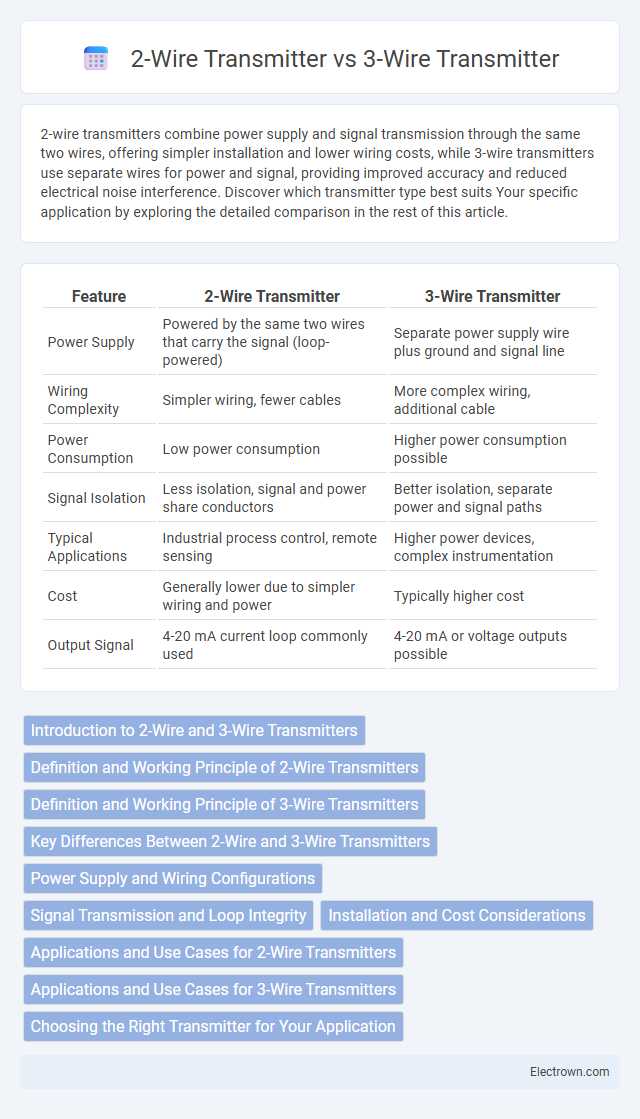2-wire transmitters combine power supply and signal transmission through the same two wires, offering simpler installation and lower wiring costs, while 3-wire transmitters use separate wires for power and signal, providing improved accuracy and reduced electrical noise interference. Discover which transmitter type best suits Your specific application by exploring the detailed comparison in the rest of this article.
Table of Comparison
| Feature | 2-Wire Transmitter | 3-Wire Transmitter |
|---|---|---|
| Power Supply | Powered by the same two wires that carry the signal (loop-powered) | Separate power supply wire plus ground and signal line |
| Wiring Complexity | Simpler wiring, fewer cables | More complex wiring, additional cable |
| Power Consumption | Low power consumption | Higher power consumption possible |
| Signal Isolation | Less isolation, signal and power share conductors | Better isolation, separate power and signal paths |
| Typical Applications | Industrial process control, remote sensing | Higher power devices, complex instrumentation |
| Cost | Generally lower due to simpler wiring and power | Typically higher cost |
| Output Signal | 4-20 mA current loop commonly used | 4-20 mA or voltage outputs possible |
Introduction to 2-Wire and 3-Wire Transmitters
2-wire transmitters integrate power supply and signal transmission within two wires, offering simplified installation and reduced wiring costs, commonly used in industrial process control for analog output signals like 4-20 mA. 3-wire transmitters separate power supply and signal return lines, providing improved signal integrity and faster response times, suitable for applications requiring higher performance and reliability. Both types serve critical roles in sensor and instrumentation systems, with the choice depending on power availability, signal quality needs, and system complexity.
Definition and Working Principle of 2-Wire Transmitters
2-wire transmitters integrate power supply and signal transmission within two wires, enabling simplified wiring and reduced installation costs. These transmitters draw power directly from the current loop, ensuring continuous operation while sending a 4-20 mA analog signal proportional to the measured variable. Your choice between 2-wire and 3-wire transmitters depends on application requirements, with 2-wire devices being ideal for minimizing wiring complexity in process control systems.
Definition and Working Principle of 3-Wire Transmitters
3-wire transmitters consist of three separate connections: power supply, ground, and output signal, allowing independent power delivery and signal transmission. Unlike 2-wire transmitters, where power and signal share the same two wires, 3-wire transmitters enhance stability and accuracy by isolating the output from the power source. Your system benefits from improved noise immunity and response time due to this separate wiring configuration.
Key Differences Between 2-Wire and 3-Wire Transmitters
2-wire transmitters combine power supply and signal transmission through the same two wires, offering simplicity and reduced wiring costs while typically limiting the output signal to current loops, such as 4-20mA. In contrast, 3-wire transmitters dedicate separate wires for power, ground, and signal, enabling higher accuracy, faster response times, and expanded output options, including voltage signals. The choice between 2-wire and 3-wire transmitters depends on application requirements, including power availability, signal fidelity, and installation complexity.
Power Supply and Wiring Configurations
A 2-wire transmitter combines its power supply and signal transmission into a single pair of wires, simplifying wiring and reducing installation costs, making it ideal for remote or hazardous environments. In contrast, a 3-wire transmitter separates the power supply and signal lines, requiring dedicated wires for power, ground, and output, offering improved signal stability and reduced electrical noise interference. Your choice between these configurations depends on the application's complexity, distance, and reliability requirements for accurate and efficient measurement.
Signal Transmission and Loop Integrity
2-wire transmitters use the same pair of wires for power supply and signal transmission, ensuring loop integrity by minimizing wiring complexity and reducing potential points of failure. 3-wire transmitters separate power and signal lines, providing more stable and noise-resistant signal transmission but requiring additional wiring that may complicate installation and affect overall loop reliability. The choice between 2-wire and 3-wire transmitters depends on balancing the need for robust loop integrity against enhanced signal quality in industrial automation systems.
Installation and Cost Considerations
2-wire transmitters simplify installation by requiring only two connections for power and signal transmission, reducing wiring complexity and labor costs. In contrast, 3-wire transmitters need separate power, ground, and signal wires, increasing installation time and material expenses. Cost considerations favor 2-wire transmitters in applications where minimizing wiring infrastructure is critical, whereas 3-wire transmitters may offer better performance but at a higher installation cost.
Applications and Use Cases for 2-Wire Transmitters
2-wire transmitters are commonly used in industrial process control applications where minimal wiring is essential, such as monitoring temperature, pressure, or flow in remote or hazardous locations. Their compatibility with two-wire current loop systems allows easy integration into existing 4-20 mA control networks, making them ideal for cost-effective and reliable signal transmission. You benefit from reduced installation complexity and maintenance costs in applications demanding compact, energy-efficient sensing solutions.
Applications and Use Cases for 3-Wire Transmitters
3-wire transmitters are widely used in applications requiring separate power supply and signal wiring, providing improved accuracy and isolation in industrial settings such as process control and automation. They are ideal for use with sensors and instrumentation where stable voltage supply and minimal signal interference are critical, including temperature, pressure, and flow measurement systems. Your choice of a 3-wire transmitter enhances reliability in environments with electrical noise or varying power conditions, ensuring precise data transmission.
Choosing the Right Transmitter for Your Application
Selecting the right transmitter for your application depends on power supply and wiring complexity. A 2-wire transmitter simplifies installation and reduces wiring costs by combining power and signal in a single cable, ideal for loops powered by 24V DC. In contrast, a 3-wire transmitter offers separate connections for power, signal, and ground, providing greater stability and signal integrity, especially useful in environments with electrical noise or when longer cable runs are required.
2-wire transmitter vs 3-wire transmitter Infographic

 electrown.com
electrown.com